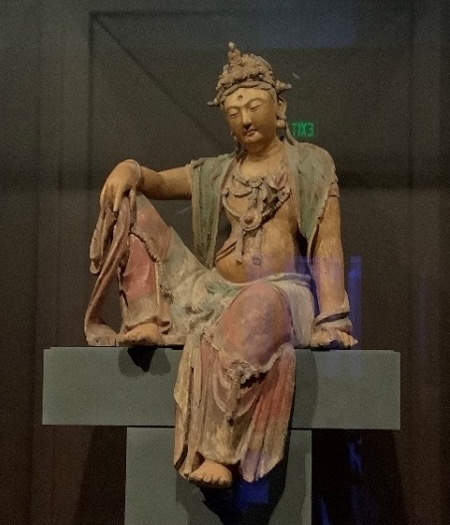Mother Love: Feminization of Water Moon Guanyin at the Boston MFA
“Guanyin, Bodhisattva of Compassion,” on display at the Boston Museum of Fine Arts, is a sculpture made of painted and gilded paulownia wood, produced in about 1200 AD during the Jin dynasty in China [1]. 1200 AD was a complex period in which the southern rulers were Southern Song emperors, and the north of China was seen as Jin. This sculpture of Guanyin may reflect the possibility that Buddhism and Bodhisattva were worshiped by more and more people at this tense time due to wars and social instability, and Guanyin sculptures naturally became numerous. However, since Buddhism or Bodhisattva was introduced to China during the 1st century BC from India, the birthplace of Buddhism, Bodhisattva was widely worshiped. Many Buddhist temples had statues and sculptures of the Bodhisattva and Buddha to receive prayers and offerings, especially during the Song and Jin periods [2]. This sculpture of Bodhisattva manufactured in the Jin/Southern Song period embodies feminine characters, revealing the feminization of Guanyin in Chinese history.
“Guanyin, Bodhisattva of Compassion” has soft feminine features and clothing. The appearance of this Guanyin is stunning as people walk in front of it. Taken as a whole, the bodhisattva seems like a gentle and benevolent female figure with downcast eyes, their smiling face peaceful and benign.  The wooden sculpture is lighter than some stone sculptures, better suited to be placed high in the interior of Buddhist temples for people to revere and worship. Isolated in the privacy of a temple room in its original context, people could directly communicate with Guanyin. For eight hundred years, Guanyin gazed down from above, compassionate, forgiving, and sympathetic to all living beings. The bodhisattva wears a high bun hairstyle and a crown with an Amitabha Buddha, with a recess in the forehead that may hold a semi-precious stone or jewel [3]. Serene and graceful, they are elegantly dressed in several gorgeous necklaces on the upper body, draped with green flowing silk cape conveying a sense of ease, in a skirt painted red and decorated with green cloth at the waist. Nevertheless, their sexuality is barely recognizable with no obvious sexual characteristics when the chest is exposed, perhaps meaning that they could be male, female, or even nonbinary.
The wooden sculpture is lighter than some stone sculptures, better suited to be placed high in the interior of Buddhist temples for people to revere and worship. Isolated in the privacy of a temple room in its original context, people could directly communicate with Guanyin. For eight hundred years, Guanyin gazed down from above, compassionate, forgiving, and sympathetic to all living beings. The bodhisattva wears a high bun hairstyle and a crown with an Amitabha Buddha, with a recess in the forehead that may hold a semi-precious stone or jewel [3]. Serene and graceful, they are elegantly dressed in several gorgeous necklaces on the upper body, draped with green flowing silk cape conveying a sense of ease, in a skirt painted red and decorated with green cloth at the waist. Nevertheless, their sexuality is barely recognizable with no obvious sexual characteristics when the chest is exposed, perhaps meaning that they could be male, female, or even nonbinary.
As stated by the object label, the sitting position indicates this sculpture should be the central figure of a larger “Water-Moon Guanyin” [4]. Although the water and moon are not displayed physically, the gesture might suggest that they sit on a lotus seat in the water. With the right leg bent and the left leg hung, the Bodhisattva sits in a relaxed manner, gazing at the reflection of the moon in the water, which reminds the viewers of the Buddhist teaching that all phenomena are illusory [5]. The elements water and moon are counted as female symbols in scholarly analysis, which accords with my recognition of traditional Chinese culture as well [6].
The special feature of this sculpture of Bodhisattva is that the Guanyin seems to own both a feminine face and a masculine or nonsexual body, which could be regarded as a transition of Bodhisattva from originally a male to a female figure in the spread of Buddhism and the process of Sinicization in China. The reasons for this feminization of Bodhisattva were complicated, according to Yu Chun-fang’s book of Kuanyin. As compassion was considered a maternal virtue in Chinese tradition, it appeared to be quite reasonable that a “Bodhisattva of Compassion” could be female [7].
“Guanyin, Bodhisattva of Compassion” in the Boston Museum of Fine Arts is astonishingly beautiful and remarkably calming, with distinct feminine characteristics and decorative elements of water and moon, despite a genderless torso. This displays the transformation process of feminizing the Bodhisattva when integrating it into Chinese culture.
[1] Object Label, Guanyin, Bodhisattva of Compassion (Museum of Fine Arts: Boston).
[6] Yu, Chun-fang. Kuanyin: The Chinese Transformation of Avalokitesvara (New York: Columbia University Press, 2001), 418.